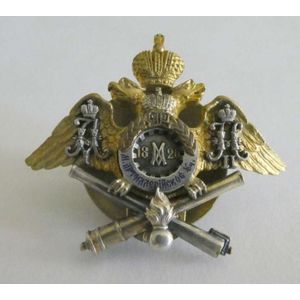Imperial Artillery School Badge
Russian Imperial Artillery School badge of the Michael Artillery School in St Petersburg Instituted 07.03.1911. Gold double headed eagle of the Nicholas I period under a gold Imperial crown, holding in its claws two crossing cannons with a silver grenade superimposed on the intersection of the cannons. On the wings of the eagle there are the silver monograms of Alexander I on the left and Nicholas II on the right. In the centre of the badge there is a silver cut of the cannon barrel under a gold Imperial crown decreased breastplate of the school. In the upper part of the cut there are two gold laurel branches. In the lower part the Inscription made by blue enamel passes: M. Artillery Sch. inside: the cut there is the gold monogram M and the date 1820 the year of the foundation of the school. A multi piece bronze gilt badge, 2 1/4 x 1 3/4 inches. Imperial eagle with monograms of Alexander I and Nicholas II on its wings, and a crowned medallion with the monogram of the Grand Duke Michail on its breast, is holding two crossed cannons and a flaming grenade laid on the cannons measures 2.13 in. wide
You must be a subscriber, and be logged in to view price and dealer details.
Register Now to view actual auction price for this item.
- Bronze - An alloy of copper and tin, traditionally in the proportions of about 9 parts of copper to 1 part of tin.
The discovery of bronze in Western Asia in the 4th century enabled people to create metal objects which were superior to those previoulsy possible because of its strength and hardness, and it has been used throughout the world for weapons, coins, tools, statuary and other decorative items.
It is very fluid in a molten state, and its hardness, strength when set, and non-corrosive properties makes it most suitable for casting sculpture. - Laurel Leaf - The use of the laurel leaf as a decorative element can be traced back to ancient Greece and Rome, where it was closely associated with victory and honour. In these cultures, the laurel was a sacred tree that was dedicated to the god Apollo and was believed to have protective and healing properties.
In ancient Greece, the laurel wreath was awarded to victors in athletic competitions, such as the Olympic Games, as a symbol of their achievement. The wreath was also associated with academic achievement, and was often worn by scholars and poets. The Greeks also used the laurel leaf as a symbol of victory in war, and it was often depicted in artwork alongside images of triumphant warriors and heroes.
The Romans continued this tradition, and the laurel wreath became a symbol of the highest military honor, the triumph, awarded to victorious generals. The wreath was also used to crown emperors and other important officials, and was often depicted in Roman art and architecture as a symbol of power and authority.
The laurel leaf is still used as a symbol of achievement, success, and excellence, and is frequently used in logos, emblems, and other branding materials. Its association with victory and honour has made it a popular choice for awards, medals, and other forms of recognition.
This item has been included into following indexes:
